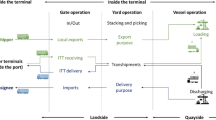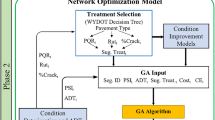Abstract
The sailing safety constraints of containerships were ignored in the previous studies on feeder containership routing problems; however, they are especially critical for small-sized feeder containerships. In this study, we optimize feeder routes while incorporating stowage plans to address the sailing safety of containerships. Firstly, a mixed integer nonlinear programming model for integrated optimization is formulated. Next, a heuristic algorithm is designed, by which feeder routes can be updated through a variable neighborhood search, and stowage plans are obtained using a genetic algorithm. Finally, through the computational study, we confirm that the integrated optimization can meet the sailing safety requirements of containerships and effectively reduce the total cost of the feeder service. Moreover, through the sensitivity analysis, we discuss the performance robustness of the proposed algorithm and further demonstrate the significance of this study.















Similar content being viewed by others
References
Alumur SA, Kara BY (2008) Network hub location problems: the state of the art. Eur J Oper Res 190(1):1–21
Ambrosino D, Paolucci M, Sciomachen A (2015) Experimental evaluation of mixed integer programming models for the multi-port master bay plan problem. Flex Serv Manuf J 27(2–3):263–284
Ambrosino D, Paolucci M, Sciomachen A (2017) Computational evaluation of a mip model for multi-port stowage planning problems. Soft Comput 21(7):1753–1763
Avriel M, Penn M, Shpirer N (2000) Container ship stowage problem: complexity and connection to the colouring of circle graphs. Discrete Appl Math 103:271–279
Dethloff J (2001) Vehicle routing and reverse logistics: the vehicle routing problem with simultaneous delivery and pick-up. Or Spektrum 23(1):79–96
Fleszar K, Osman I, Hindi KS (2009) A variable neighborhood search algorithm for the open vehicle routing problem. Eur J Oper Res 195:803–809
Fontes F, Goncalves G (2017) A new hub network design integrating deep sea and short sea services at liner shipping operations. Int J Ship Trans Log 9(5):580
Gelareh S, Maculan N, Mahey P, Monemi RN (2013) Hub-and-spoke network design and fleet deployment for string planning of liner shipping. Appl Math Model 37(5):3307–3321
Gelareh S, Pisinger D (2011) Fleet deployment, network design and hub location of liner shipping companies. Trans Res E-Log 47(6):947–964
Hansen P, Mladenovic N (1997) Variable neighborhood search for the p-median. Locat Sci 5:207–226
Hansen P, Mladenovic N, Perez JAM (2010) Variable neighborhood search: methods and applications. Ann Oper Res 175:367–407
Hsu CI, Hsieh YP (2007) Routing, ship size, and sailing frequency decision-making for a maritime hub-and-spoke container network. Math Comput Model 45(7–8):899–916
Ji MJ, Shen LX, Shi BS, Xue Y, Wang F (2015) Routing optimization for multi-type containerships in a hub-and-spoke network. J Traffic Transp Eng (Engl Ed) 2(5):362–372
Kammoun M, Derbel H, Ratli M, Jarboui B (2015) A variable neighborhood search for solving the multi-vehicle covering tour problem. Electron Notes Discrete Math 47:285–292
Karlaftis MG, Kepaptsoglou K, Sambracos E (2009) Containership routing with time deadlines and simultaneous deliveries and pick-ups. Transp Res E-Log 45(1):210–221
Potvin JY (1996) Genetic algorithms for the traveling salesman problem. Ann Oper Res 63(3):337–370
Sambracos E, Paravantis JA, Tarantilis CD, Kiranoudis CT (2004) Dispatching of small containers via coastal freight lines: the case of the Aegean Sea. Eur J Oper Res 152(2):365–381
Suban TD, Twrdy E (2008) Decision support for optimal repositioning of containers in a feeder system. Promet -Traffic Transp 20(2):71–77
Wilson ID, Roach PA (2000) Container stowage planning: a methodology for generating computerised solutions. J Oper Res Soc 51(11):1248–1255
Zhang E, Mei QH, Liu M, Zheng FF (2018) Stowage planning in multiple ports with shifting fee minimization. Sci Program Sci Program 2018:1–9. https://doi.org/10.1155/2018/3450726
Zhang XY, Ji MJ, Yao S, Chen X (2015) Optimising feeder routing for container ships through an electronic chart display and information system. J Navig 68(5):848–868
Zheng J, Meng Q, Sun Z (2015) Liner hub-and-spoke shipping network design. Transp Res E-Log 75:32–48
Zhu HL, Ji MJ (2014) Optimal model and improved genetic algorithm of containership stowage on full route. J Traffic Transp Eng 14(5):59–67
Acknowledgements
This work was funded by the National Nature Science Foundation of China [Grant Numbers 71971035 71572022].
Author information
Authors and Affiliations
Corresponding author
Ethics declarations
Conflicts of interest
Lingrui Kong declares that she has no conflict of interest. Mingjun Ji declares that he has no conflict of interest. Yunxiao Guan declares that he has no conflict of interest.
Ethical approval
This article does not contain any studies with human participants or animals performed by any of the authors.
Additional information
Communicated by V. Loia.
Publisher's Note
Springer Nature remains neutral with regard to jurisdictional claims in published maps and institutional affiliations.
Appendices
Appendix A
Formulations for GM, T, and Ms
a. GM can be calculated as \(GM=KM-KG\). KM is the distance between the keel and metacenter of the containership, it is related to the draft, and can be accurately determined using the hydrostatic curve provided by the containership; KG is the distance between the keel and center of gravity of the containership, which can be calculated as \(KG=\frac{\sum _{s\in S_k}W_b^{ks}\times H_s}{D}\), where D is the loaded displacement of the containership and \(H_s\) is the height of the center of slot s.
b. Ms can be calculated as \(Ms=\frac{1}{2}\times (\gamma \times DL +\sum _{s\in S_k}W_b^{ks}\times I_s-D\times f\times L)\). \(\gamma \) is the equivalent arm of the total moment of the deadweight of the first and the latter half to the center cross section of the containership; DL is the light displacement of the containership; \(I_s\) is the horizontal distance between slot s and the vertical center of the containership; f is the equivalent arm of the buoyancy of the containership; and L is the length of the containership.
c. The trim can be calculated as \(T=\frac{\sum _{s\in S_k}I_s\times W_b^{ks}-LCB\times D}{MCT\times 100}\). LCB is the distance between the center of buoyancy and the vertical center of the containership and can be obtained from the trim diagram of the containership; and MCT is the moment required to change the trim of the containership by 1 cm, which can also be obtained from the trim diagram.
Appendix B
The framework of Hierarchical optimization-I and hierarchical optimization-II is shown in Tables 13 and 14, respectively.
Rights and permissions
About this article
Cite this article
Ji, M., Kong, L. & Guan, Y. Integrated optimization of feeder routing and stowage planning for containerships. Soft Comput 25, 4465–4487 (2021). https://doi.org/10.1007/s00500-020-05456-9
Published:
Issue Date:
DOI: https://doi.org/10.1007/s00500-020-05456-9




